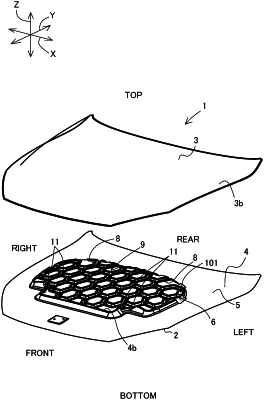| CPC B62D 25/12 (2013.01) [B60R 2021/343 (2013.01)] | 18 Claims |

|
1. An automobile inner panel, comprising:
a plurality of sub-units each including a flange, an inclined wall continuous with the flange, and a bottom portion continuous with the inclined wall and separated from the flange,
wherein:
the bottom portions of the sub-units which are adjacent to each other are butted against each other and are directly continuous with each other;
a maximum value of a distance between two of the flanges of two of the sub-units in which the bottom portions are arranged separated from each other and which are adjacent to each other is 250 mm or less; and
at least at one part of an outermost circumferential sub-unit, which is the sub-unit arranged adjacent to an outer circumferential edge of the automobile inner panel, a height from the bottom portion to the flange is lower than a height from the bottom portion to the flange in another sub-unit.
|